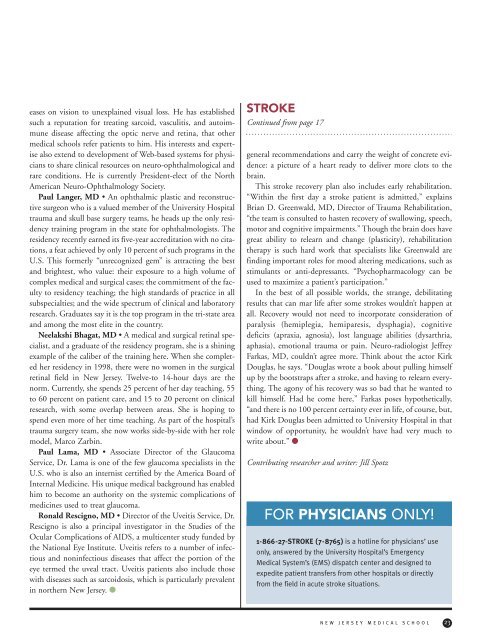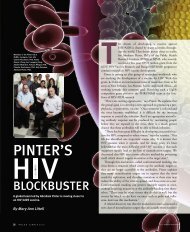changing the course of stroke - New Jersey Medical School ...
changing the course of stroke - New Jersey Medical School ...
changing the course of stroke - New Jersey Medical School ...
Create successful ePaper yourself
Turn your PDF publications into a flip-book with our unique Google optimized e-Paper software.
eases on vision to unexplained visual loss. He has established<br />
such a reputation for treating sarcoid, vasculitis, and autoimmune<br />
disease affecting <strong>the</strong> optic nerve and retina, that o<strong>the</strong>r<br />
medical schools refer patients to him. His interests and expertise<br />
also extend to development <strong>of</strong> Web-based systems for physicians<br />
to share clinical resources on neuro-ophthalmological and<br />
rare conditions. He is currently President-elect <strong>of</strong> <strong>the</strong> North<br />
American Neuro-Ophthalmology Society.<br />
Paul Langer, MD • An ophthalmic plastic and reconstructive<br />
surgeon who is a valued member <strong>of</strong> <strong>the</strong> University Hospital<br />
trauma and skull base surgery teams, he heads up <strong>the</strong> only residency<br />
training program in <strong>the</strong> state for ophthalmologists. The<br />
residency recently earned its five-year accreditation with no citations,<br />
a feat achieved by only 10 percent <strong>of</strong> such programs in <strong>the</strong><br />
U.S. This formerly “unrecognized gem” is attracting <strong>the</strong> best<br />
and brightest, who value: <strong>the</strong>ir exposure to a high volume <strong>of</strong><br />
complex medical and surgical cases; <strong>the</strong> commitment <strong>of</strong> <strong>the</strong> faculty<br />
to residency teaching; <strong>the</strong> high standards <strong>of</strong> practice in all<br />
subspecialties; and <strong>the</strong> wide spectrum <strong>of</strong> clinical and laboratory<br />
research. Graduates say it is <strong>the</strong> top program in <strong>the</strong> tri-state area<br />
and among <strong>the</strong> most elite in <strong>the</strong> country.<br />
Neelakshi Bhagat, MD • A medical and surgical retinal specialist,<br />
and a graduate <strong>of</strong> <strong>the</strong> residency program, she is a shining<br />
example <strong>of</strong> <strong>the</strong> caliber <strong>of</strong> <strong>the</strong> training here. When she completed<br />
her residency in 1998, <strong>the</strong>re were no women in <strong>the</strong> surgical<br />
retinal field in <strong>New</strong> <strong>Jersey</strong>. Twelve-to 14-hour days are <strong>the</strong><br />
norm. Currently, she spends 25 percent <strong>of</strong> her day teaching, 55<br />
to 60 percent on patient care, and 15 to 20 percent on clinical<br />
research, with some overlap between areas. She is hoping to<br />
spend even more <strong>of</strong> her time teaching. As part <strong>of</strong> <strong>the</strong> hospital’s<br />
trauma surgery team, she now works side-by-side with her role<br />
model, Marco Zarbin.<br />
Paul Lama, MD • Associate Director <strong>of</strong> <strong>the</strong> Glaucoma<br />
Service, Dr. Lama is one <strong>of</strong> <strong>the</strong> few glaucoma specialists in <strong>the</strong><br />
U.S. who is also an internist certified by <strong>the</strong> America Board <strong>of</strong><br />
Internal Medicine. His unique medical background has enabled<br />
him to become an authority on <strong>the</strong> systemic complications <strong>of</strong><br />
medicines used to treat glaucoma.<br />
Ronald Rescigno, MD • Director <strong>of</strong> <strong>the</strong> Uveitis Service, Dr.<br />
Rescigno is also a principal investigator in <strong>the</strong> Studies <strong>of</strong> <strong>the</strong><br />
Ocular Complications <strong>of</strong> AIDS, a multicenter study funded by<br />
<strong>the</strong> National Eye Institute. Uveitis refers to a number <strong>of</strong> infectious<br />
and noninfectious diseases that affect <strong>the</strong> portion <strong>of</strong> <strong>the</strong><br />
eye termed <strong>the</strong> uveal tract. Uveitis patients also include those<br />
with diseases such as sarcoidosis, which is particularly prevalent<br />
in nor<strong>the</strong>rn <strong>New</strong> <strong>Jersey</strong>. ●<br />
STROKE<br />
Continued from page 17<br />
general recommendations and carry <strong>the</strong> weight <strong>of</strong> concrete evidence:<br />
a picture <strong>of</strong> a heart ready to deliver more clots to <strong>the</strong><br />
brain.<br />
This <strong>stroke</strong> recovery plan also includes early rehabilitation.<br />
“Within <strong>the</strong> first day a <strong>stroke</strong> patient is admitted,” explains<br />
Brian D. Greenwald, MD, Director <strong>of</strong> Trauma Rehabilitation,<br />
“<strong>the</strong> team is consulted to hasten recovery <strong>of</strong> swallowing, speech,<br />
motor and cognitive impairments.” Though <strong>the</strong> brain does have<br />
great ability to relearn and change (plasticity), rehabilitation<br />
<strong>the</strong>rapy is such hard work that specialists like Greenwald are<br />
finding important roles for mood altering medications, such as<br />
stimulants or anti-depressants. “Psychopharmacology can be<br />
used to maximize a patient’s participation.”<br />
In <strong>the</strong> best <strong>of</strong> all possible worlds, <strong>the</strong> strange, debilitating<br />
results that can mar life after some <strong>stroke</strong>s wouldn’t happen at<br />
all. Recovery would not need to incorporate consideration <strong>of</strong><br />
paralysis (hemiplegia, hemiparesis, dysphagia), cognitive<br />
deficits (apraxia, agnosia), lost language abilities (dysarthria,<br />
aphasia), emotional trauma or pain. Neuro-radiologist Jeffrey<br />
Farkas, MD, couldn’t agree more. Think about <strong>the</strong> actor Kirk<br />
Douglas, he says. “Douglas wrote a book about pulling himself<br />
up by <strong>the</strong> bootstraps after a <strong>stroke</strong>, and having to relearn everything.<br />
The agony <strong>of</strong> his recovery was so bad that he wanted to<br />
kill himself. Had he come here,” Farkas poses hypo<strong>the</strong>tically,<br />
“and <strong>the</strong>re is no 100 percent certainty ever in life, <strong>of</strong> <strong>course</strong>, but,<br />
had Kirk Douglas been admitted to University Hospital in that<br />
window <strong>of</strong> opportunity, he wouldn’t have had very much to<br />
write about.” ●<br />
Contributing researcher and writer: Jill Spotz<br />
FOR PHYSICIANS ONLY!<br />
1-866-27-STROKE (7-8765) is a hotline for physicians’ use<br />
only, answered by <strong>the</strong> University Hospital’s Emergency<br />
<strong>Medical</strong> System’s (EMS) dispatch center and designed to<br />
expedite patient transfers from o<strong>the</strong>r hospitals or directly<br />
from <strong>the</strong> field in acute <strong>stroke</strong> situations.<br />
NEW JERSEY MEDICAL SCHOOL 23






